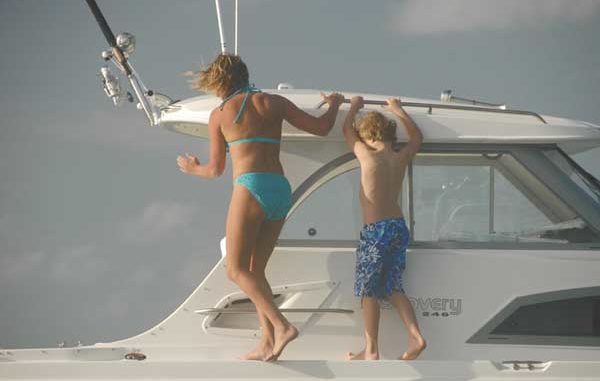
Here’s a look at some more trophies that were dropped during the 2007-08 season.
Just as most injuries at home are caused by slips and falls, tripping and slipping are common accidents aboard boats, with the added threat of falling down and out of the boat. Slipping on a wet deck is the most common cause of lost footing aboard any watercraft, which is why textured “non-skid” surfaces are often applied to decks and areas where secure footing is critical.
If you’ve identified slick areas where you or passengers may slip or already have slipped, you can install skid-resistant step pads or apply self-adhesive strips of non-skid tape to provide more-secure footing.
Another way to help keep guests upright and aboard your boat is to ask that they wear tennis shoes or bona-fide boat shoes with non-slip soles.
Boat handling can also affect the stability of people aboard your watercraft. Avoid “shot-gun” starts and abrupt stops or turns. Maintain a steady speed when changing direction, taking turns as wide as the conditions will allow.
Before each and every time you get under way over the course of the boating day, make sure all passengers are seated, wearing PFDs if required and aware that the boat will be moving so that they can brace themselves for motion. Guests who don’t compensate for acceleration and deceleration when the boat starts, stops or turns are prime candidates for losing their balance and perhaps going over the side. You should also advise against anyone walking around while the boat is under way for the same reason.
Call to action
In the event someone does end up over the side of your boat, the first order of action is to identify where the person is in the water and maintaining visual contact with him. If there is another passenger in the boat, assign him to watch the person who is in the water, pointing to provide you with a location reference. If you are the lone person remaining aboard, you’ve got to be prepared to operate the boat and do your best to maintain the victim’s location in relation to the watercraft.
If you are under way when the person falls over, and you or someone else aboard is in visual contact with the victim, the first action to take is to slow the boat’s forward progress and turn to get back to the victim in a safe manner.
Of four different “man overboard” maneuvers for powerboats tested by the Safety at Sea Committee of the Seattle Sailing Foundation, an immediate reduced-speed turn met every criteria for small-craft man-overboard rescue situations. The method is quick, keeps the boat close to the victim and can be conducted by even inexperienced boaters.
Other than drowning, the most immediate threat to a person who has fallen overboard is presented by the boat and motor of the rescue craft. That is why it is important to know exactly where the victim is in relation to the boat at all times.
When conditions allow, approach the victim from downwind, so that the boat will not be knocked into the victim by wind or waves. When coming alongside the victim, the engine should be placed in neutral while the person is helped back aboard.
The Williamson Turn
If someone falls overboard in conditions of reduced visibility, such as at night or in fog or high waves, or for any other reason the location of the victim is not known, the best tactic to take to retrace the boat’s path is called the Williamson Turn.
The technique calls for slowing and turning the steering wheel all the way (“hard over”) toward the side of the craft that the person is believed to have fallen over, and holding it there until the boat’s heading has changed 60 degrees from the direction the boat was headed when the incident took place.
At that point, the wheel is turned all the way to the opposite side to bring the boat around 240 degrees in the other direction. That will place the boat’s heading back on the reciprocal course, which can be followed to retrace the boat’s progress in an attempt to locate the person who went over the side.
Current factors
Water current can make falling overboard, or going over the side intentionally, from an anchored boat just as dangerous as an overboard experience when the watercraft is under way. Even moderate current created by tidal flow or when boating in a river can quickly sweep a swimmer away from the boat, and rescue efforts will be delayed by having to pull up the anchor and get the boat started.
When anchored or docked in an area of current, regard it as an under way situation by wearing PFDs and explain the situation and its perils to your passengers.
Skid-free aftermarket
Attwood Marine offers two sizes of step pads that can be installed in high-traffic areas on the tops of gunwales to prevent slippage. The aftermarket pads feature a skid-proof, black vinyl insert placed inside a stainless steel frame that is secured to the deck with No. 8 screws from Attwood at 616-897-9241; www.attwoodmarine.com.
Peel-and-stick, self-adhesive Safety Track Strips are skid-proof even when wet, can be trimmed to size for custom fit and come in black or gray. A 1-inch-wide, 180-inch-long roll or six 2×12-inch panels are about $8 from Cabela’s, 800-237-4444; www.cabelas.com.


